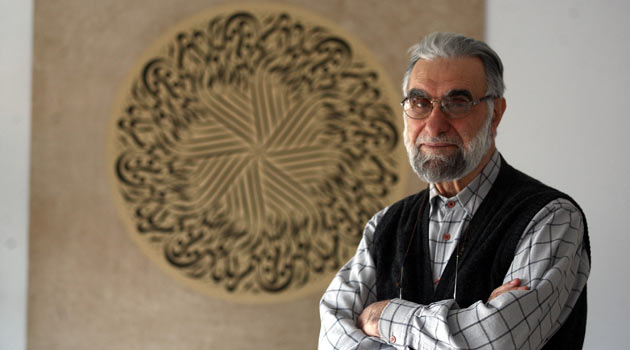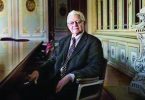Istanbul, the city blessed with being the place where The Quran was written, was home to the Ottoman Calligraphy School established by the famous calligraphist Sheik Hamdullah from Amasya during the 16th century. Despite loosing its old fame and being on the brinks of fading away after the Alphabet Reform in 1928, calligraphy still relevantly holds its exceptional place. In that, with the death of calligraphist Hamid the concern that ‘This art has now perished, it will not revive again…’ grew, only to be erased and revived by Hasan Çelebi, his student, who, so to say, rose from his ashes like a simurg. Calligraphist Hamid, who had asked Hafiz Hasan to engrave his tomb stone, put an extra responsibility on Çelebi´s shoulders. In fact, this meant that he had handed down his legacy to Hafiz Hasan in his own style. Hence, it is impossible to talk about calligraphy, its history and importance without mentioning the calligraphist Hasan Çelebi. It, can be said that Hasan Çelebi is the cornerstone of the last era of calligraphy just as İbn Mukle, Ali b. Hilal and Yakut-ı Müsta’simi were during the first era.
It cannot be said that Hasan Çelebi reached the aim on this distant and difficult mission so easily. This point cannot be swiftly explained. Aren´t the rules and standards for this art, to which he had committed himself completely, so laboured and arduous? With divine fate, he had the opportunity to come from a remote village of Anatolia to Istanbul, and engage in religious studies. In his own words, he called himself a poor child from a village who was given an oppurtunity to mingle with the elites of Istanbul who were raised in an Ottoman culture, and yet, this boy worked with great determination and patience, decorating mosques with his work, educating students and most importantly establishing a new international school with steady steps towards a future while still staying loyal to the traditions of the history of the art of calligraphy.
Çelebi is known to have taught most students after Hâmid Aytaç upon recieving his ‘icazet’ (permission-diploma recieved from a madrasah) the ‘sülüs-nesih’ (authority to copy Ottoman scripts) from Hamid Bey and ‘ta’lik- rik’a’ (a writing style in calligraphy) from Kemal Batanay. Today, he has more than 70 students with approbation all over the world including the U.S.A, Japan, Russia and South Africa. His reputation has gone beyond borders, making him renowned in international culture and art circles, with the students he has taught, while his calligraphy embellishes places of worship and the many precious pieces of art which he has created.
Teaching students is just as important as producing works of art because the continuation and survival of an art depends on this fact. The value of some artists in history is measured not only with their art but also with the students they have educated. Important calligraphists such as Davud Bektaş, Muhammed Zekeriya, Ferhat Kurlu and Fuad Kuchi Honda, who were trained by Çelebi Hodja, ought to actually be conceived as the calligraphist’s most important works of art. So to speak, feeding a well-spring is important if you wish to use its water.
He has produced many works of art up until today and still continues to do so. As an attribute of the calligraphers of this last century, the ability to write in all forms of calligraphic writing styles is found in Çelebi Hodja. He has produced work written with the classical writing styles such as ‘sülüs’, ‘nesih’, ‘tâlik’, ‘dîvânî’, ‘celî dîvânî’, ‘muhakkak’ and ‘rik’a’ as well as producing art work in the ‘kûfî’ style. However, most of his pieces are written in the ‘celî sülüs’ style. The value of an artist cannot be meaured with the number of art pieces he has produced, but we can say that Çelebi has created a significant amount of work. Most of them consist of sanctuary writings. Today many mosques that have gone through restorations and the braces and domes in new mosques are decorated with his celî sülüs style. Besides writing on classic framed paintings and paper, he has also written in the form of the sultan’s signature (tughra). He has presented many important statesmen with his tughra art. He ensures the continuation of our classic writing methods by writing inscriptions describing the Prophet Muhammad (hilye) and by using the ‘kıt’a’ writings. Sticking to the classic methods of writing, the calligraphist is not afraid to use different compositions creating unique and precious works of art.
Despite not being against modern applications, he pursued the classical traditions. However, he avoided being rigid here and sometimes produced modern works that embraced the classical tradition’s most important features within it. He remained loyal to the guidelines of the composition, yet is free within. According to the calligraphist calligraphy has a classic and traditional spirit and this spirit should never disappear. Many things can still be done in this field. The border-lines are broad and the satisfaction point still remains unattained. There is an endless field before us, and this field ought to be further enriched with classic traditions.
Hasan Çelebi has never put his ego before his art. Always acting in moderation since he was young, he never fought with anyone and always acted with care towards his students. He really holds the attributes of his surname meaning; kind, affable and gentleman. He is the gentleman of calligraphy who never imposed his rules on anyone. His only rule was the measure of his pen; he himself never found faults but the pen did. A gentle soul, which never breaks a single heart but takes them under its wings. All these features he had, came from his tolerance. Requiring a great amount of patience, Hasan Çelebi has become one soul with calligraphy. His patience with his work has reflected on to his daily life.









Leave a Comment